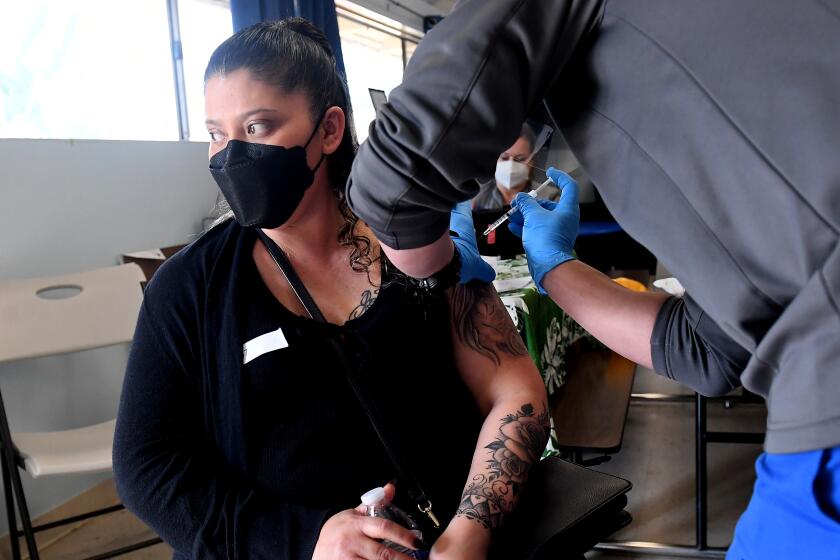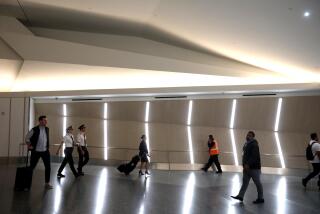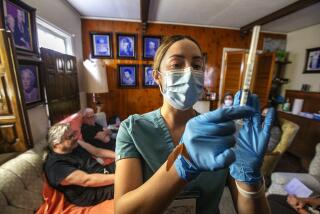California’s COVID-19 vaccinations rise as U.S. struggles. Does the lottery deserve credit?

- Share via
SAN FRANCISCO — After a steep and sustained decline, California’s COVID-19 vaccination rate rose markedly earlier this month, outpacing the inoculation trends in much of the country, a Los Angeles Times data analysis shows.
The recent boost in vaccinations in the Golden State is a bright spot that comes as officials confirmed Tuesday that the nation probably will fall short of President Biden’s goal of administering at least one dose to 70% of U.S. adults by July 4. California is one of 16 states, along with the District of Columbia, that have reached that target, but it will take a few more weeks after the Fourth of July for the nation as a whole to meet the benchmark.
California has long been a leader in vaccinations. But the uptick in recent weeks offers an early suggestion that Gov. Gavin Newsom’s elaborate — and, in some corners, derided — program offering the chance at cash prizes to those who got vaccinated may have reaped some rewards.
While it’s impossible to say for certain why each individual resident decided to get inoculated, the timing is nevertheless striking, and some suggest the state’s $116.5-million incentive program probably sparked renewed interest in the shots.
“I guess the lottery is working,” UC San Francisco epidemiologist Dr. George Rutherford said at a recent online forum, adding later in an interview: “I think we have evidence that it’s had an impact.”
California will offer what appears to be the largest COVID-19 incentive in the nation: the chance for 10 residents to win $1.5 million apiece.
By the end of May and into early June, California’s average daily number of doses administered over a weekly period fell to a low of about 120,000, a precipitous plunge from a peak of more than 400,000 doses a day in early April.
In the face of this steep decline, the state tried a new tack to tempt those still on the fence: the prospect of cold, hard cash.
“You saw across the country a decline in [the] total number of people getting vaccinated. There were efforts in states large and small to stem that by doing incentives, cash prizes. California was no different,” Newsom said last week.
But, he continued, “we are the biggest state. And so we have the biggest cash giveaways.”
Newsom unveiled the details on May 27: In a series of drawings held through June, 30 Californians would win $50,000 apiece and 10 would take home grand prizes of $1.5 million each.
Two million $50 gift cards also were made available to residents who received their first dose starting the day the lottery was announced.
Selecting the winners took on a game-show feel — complete with jaunty music, lottery-style random number drawings, oversized checks and confetti drops.
The spectacle hit peak California on June 15, when the grand prize winners were chosen at Universal Studios Hollywood while reporters, tourists and costumed movie characters such as Minions, Trolls, Shrek and Optimus Prime looked on.
Similar programs have been successful elsewhere. Ohio’s Vax-a-Million lottery program, which offered $1-million prizes and full-ride four-year college scholarships to vaccinated people, led to a 55% increase in vaccination rates among adults in their 20s, 30s and 40s in the days after the program was announced, the White House has said.
Some skeptics, though, have questioned the efficacy of, as well as the wisdom behind, such incentive programs.
Political opponents have also dismissed Newsom’s flashy giveaways as little more than attempts to either distract from his forthcoming recall election or shore up support at taxpayer expense.
But did it work?
Gov. Newsom selected 10 top winners Tuesday in California’s COVID-19 vaccine sweepstakes. Each takes home $1.5 million.
The Times analyzed vaccination data from the U.S. Centers for Disease Control and Prevention to determine the average number of doses administered daily by California during the weeks of May 27 to June 2 and June 3 through June 9, then calculated the percentage change.
California administered an average of 121,000 doses each day the first week, and about 161,000 doses daily the following week — a 33% increase.
Only five states had a larger percentage increase in administered vaccinations from one time period to the next: Montana, Utah, Georgia, South Carolina and New Hampshire.
Comparatively, the average daily number of vaccinations nationwide increased during those two weeks by about 14%, according to The Times’ analysis.
For the most recent seven-day period in which vaccination numbers are relatively reliable, between June 6 and June 12, an average of 132,000 doses a day were being administered — a decline from the peak but still higher than it was at the end of May and in early June.
More recent numbers are not as reliable because it can take many days before the state receives information on all doses administered for a recent date.
“These incentives have worked,” Newsom said during a news conference last week at Six Flags Magic Mountain.
So far, the trendline in California’s vaccination pace has resembled one of the theme park’s famed roller coasters. There was a steady rise from mid-December through the early part of April, followed by a nosedive.
Aside from the recent bump, the only other temporary reversal came around the time the statewide vaccine eligibility pool expanded to include residents as young as 12.
California has one of the highest vaccination rates in the nation, with 73% of adults — and 57% of residents of all ages — vaccinated with at least one dose, according to data compiled by The Times.
However, officials have long noted that progress is not uniform throughout the state.
In particular, substantial numbers of Latino and Black Californians remain unvaccinated. Only 41% of California’s Black and Latino residents are at least partially vaccinated, compared with 54% of Native American, 56% of white and 69% of Asian American and Pacific Islander residents.
Concerns have also been raised that low vaccination rates in parts of California’s rural north or the Central Valley may leave those areas vulnerable to future outbreaks.
“This is, in fact, now a pandemic of unvaccinated people,” Los Angeles County Public Health Director Barbara Ferrer said Monday.
Coronavirus case rates for Black residents dropped by 13% and by 22% for Latino residents, while cases have dropped by 33% for white residents.
But some experts say it’s also important to consider naturally acquired immunity in weighing the risk of future surges.
Having a previous history of high numbers of cases “means there’s probably high rates of naturally acquired immunity,” Rutherford said.
Testing of Californians in May for whether they have antibodies to the coronavirus — because of either vaccination or having survived an infection — found that 76.6% of state residents had such antibodies, according to analysis published by the state Department of Public Health.
It was as high as 86.5% in the southern border region that includes San Diego and Imperial counties and 80.5% in a region that includes the Bay Area and Monterey and Santa Cruz counties, and as low as 54.4% in rural Northern California.
Rates also were relatively high in an area that includes Orange County, the Inland Empire and the Owens Valley, where 76.8% of those tested had antibodies; and in the San Joaquin Valley, 76.3%. In L.A. County, the Central Coast and the Greater Sacramento area, between 70% and 74% of those tested had antibodies.
Experts estimate that 70% to 85% of a population needs to have some degree of protection against the coronavirus for a region to achieve “herd immunity” or “community immunity,” in which a disease is effectively starved of opportunities to move from person to person, putting a lid on outbreaks and helping shield even those who are unvaccinated or have weakened immune systems.
Santa Clara County had the first recorded COVID-19 death in the nation. Now, more than 71% of its residents are at least partially vaccinated against the illness.
However, others caution that it’s unclear how long someone who was previously infected remains immune. Government health officials have said that immunity from vaccinations is better and longer lasting than immunity from infection.
Ferrer has guessed that L.A. County will get to herd immunity when 80% of residents 16 and older are vaccinated. Currently, 67% of residents in that age group are vaccinated, and officials — for now — are projecting the county could meet the threshold for herd immunity by the end of summer.
“For those people who have already been sick, that natural immunity will wane and they do need to come in and go ahead and get vaccinated,” Ferrer said. “So the numbers that we’re still watching are, in fact … what percent of our population has been vaccinated.”
Getting to that level, though, remains a tall order — one that officials acknowledge will probably entail individualized attention to holdouts.
But there’s always incentives. California is still offering the chance to win one of six vacation packages to destinations including Disneyland, a spa in Palm Springs, San Diego for surfing lessons, a Giants game in San Francisco and floor seats for a Lakers game.
Various other goodies — including free food and tickets to Six Flags parks — are also up for grabs.
“We’ll continue to promote incentives as long as they work,” Newsom said.
Lin reported from San Francisco, Money and Stiles from Southern California.
More to Read
Sign up for Essential California
The most important California stories and recommendations in your inbox every morning.
You may occasionally receive promotional content from the Los Angeles Times.



















